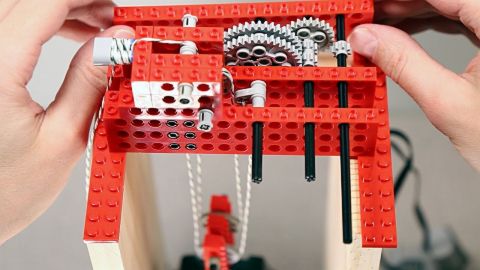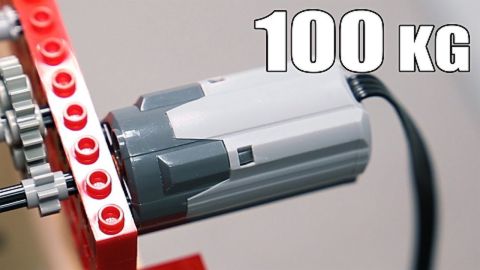Using LEGO pieces to build mechanical creations is a popular hobby, as evidenced by all the crazy and impressive contraptions featured on LEGO forums, blogs, and YouTube channels. LEGO themselves runs a very interesting series on their own YouTube channel titled Beyond the Instructions, featuring all kinds of LEGO-built machines. We talked about them here and here. If you are interested to build your own mechanical creations, it is very useful to know the limitations of LEGO as a building medium before investing time and money into a complex project. 🙂

A YouTube channel that I recently discovered focuses on testing the capabilities and limitations of LEGO Technic elements. Aptly named the Brick Experiment Channel, they test the breaking points of LEGO pulleys, gears, motors, axles, wheels, and more. At the time of this writing, there are only six videos on the channel, but they are all very educational and could be useful in your own LEGO creations.

The first experiment demonstrates how much weight can be lifted with LEGO tackles and a LEGO Power Functions M-motor, and what is the best combination of pulleys and tackles to lift the maximum amount of weight. The experiment does a similar test with different gear combinations. The third experiment combines gears and pulleys/tackles to generate the maximum possible lift with a LEGO Power Functions M-motor. All these tests are done carefully in small increments to be able to record the results, and learn from mistakes and blow-ups that happen along the way. Also, notice the effect weight has on the support beams and other parts!

Speaking of the effect of weight on LEGO parts, the fourth video shows what happens when a LEGO Power Functions M-motor with gears and pulleys tries to lift a hefty 102.2 kg (gear ratio 15:1 and tackle velocity ratio 8:1). I particularly like the slow-motion demonstration of the axles, beams, and strings at their breaking point. Lots to learn, and learn from! (By the way, only LEGO parts were used for these tests with the exception of the strings.)
The fifth experiment sacrifices a LEGO axle to see how it deforms/breaks when high torque is applied with a LEGO Power Functions M-motor. Here are the test results for reference: 1:1 (40 mNm) – ok, 3:1 (110 mNm) – ok, 5:1 (180 mNm) – slight permanent deformation, 9:1 (300 mNm) – serious permanent deformation, 15:1 (500 mNm) – even more serious permanent deformation, – (? mNm) – breaks in half.
In the sixth and final experiment (so far), a LEGO wheel is tested to see how fast it can rotate using LEGO motors and various combinations of gears. It can actually handle 2850 RPM pretty well. There are plans to redo the same test without a tire on the wheel, and with some lubrication, which may allow higher RPM. You can watch all the videos in the player below.
While there are only six videos on the channel at the time of this writing, they are enthusiastic to continue with future projects. They are also open to suggestions, so if you would like to see some other tests, leave them a comment on their YouTube channel, and subscribe to get updates. Experiments like these are particularly helpful if you are working on large LEGO models that need to handle weight and/or have moving components. If you like to play with mechanical models, some of the larger LEGO Technic sets include parts and mechanisms that are great for experimentation and learning. A couple of currently available examples are the #42055 LEGO Technic Bucket Wheel Excavator, and the #42070 LEGO Technic 6×6 All Terrain Tow Truck. You can find them at the LEGO Technic section of the Online LEGO Shop.

What do you think? How do you like these demonstration videos? What other experiments would you like to see? Have you ever tested the capacity of your own LEGO parts or models? Feel free to share and discuss in the comment section below! 😉
And you might also like to check out the following related posts:












I’ve seen one of those recently. The ‘let’s see if we can twist a Lego technic axel into a piece of Twizzler’s licorice’ one. 😀 I need to check out the rest of them as I wasn’t aware there were more.
That’s one of the most recent experiments. I highly recommend checking out the others too. 😀
I love to watch experiments like this! Very interesting. Tastefully done and edited videos too. I like that he is staying with just a couple of colors. I hope he is wearing protective gear!
These are the type of test that girl should be doing who was featured here last week. She made good videos but was senselessly destroying Lego.
Hm… she had a different approach, but ideas like this can certainly be combined.
Wow! It’s scary when they finally pop! Very interesting experiments! I would like to see something comparing the capabilities of different motors. He may not want to burn out a bunch of expensive lego motors though, which is understandable.
There are some pretty extensive comparisons on LEGO motors at Eurobricks and other places. But if you mean, “let’s see what we could do to burn up a LEGO motor”, then yeah, people may not want to volunteer. 😈
LOL! I would love to do stuff like this! But I don’t want to destroy my Lego!
Hmmm, many of these contraptions appear quite old-school, maybe it’s due to all these studded beams…
He is just keeping them simple and skeletal, only using the minimum number of parts needed for each test. They are not meant to look like finished models, which does make them look like some of the really old Technic sets. 😀
My son loves toys like this.